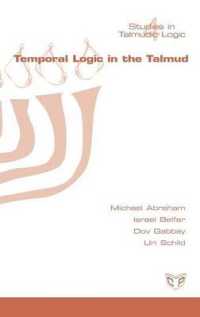- ホーム
- > 洋書
- > 英文書
- > Science / Mathematics
Full Description
The state-space approach provides a formal framework where any result or procedure developed for a basic model can be seamlessly applied to a standard formulation written in state-space form. Moreover, it can accommodate with a reasonable effort nonstandard situations, such as observation errors, aggregation constraints, or missing in-sample values.
Exploring the advantages of this approach, State-Space Methods for Time Series Analysis: Theory, Applications and Software presents many computational procedures that can be applied to a previously specified linear model in state-space form.
After discussing the formulation of the state-space model, the book illustrates the flexibility of the state-space representation and covers the main state estimation algorithms: filtering and smoothing. It then shows how to compute the Gaussian likelihood for unknown coefficients in the state-space matrices of a given model before introducing subspace methods and their application. It also discusses signal extraction, describes two algorithms to obtain the VARMAX matrices corresponding to any linear state-space model, and addresses several issues relating to the aggregation and disaggregation of time series. The book concludes with a cross-sectional extension to the classical state-space formulation in order to accommodate longitudinal or panel data. Missing data is a common occurrence here, and the book explains imputation procedures necessary to treat missingness in both exogenous and endogenous variables.
Web Resource
The authors' E4 MATLAB® toolbox offers all the computational procedures, administrative and analytical functions, and related materials for time series analysis. This flexible, powerful, and free software tool enables readers to replicate the practical examples in the text and apply the procedures to their own work.
Contents
Introduction
Linear state-space models
The multiple error model
Single error models
Model transformations
Model decomposition
Model combination
Change of variables in the output
Uses of these transformations
Filtering and smoothing
The conditional moments of a state-space model
The Kalman filter
Decomposition of the smoothed moments
Smoothing for a general state-space model
Smoothing for fixed-coefficients and single-error models
Uncertainty of the smoothed estimates in a fixed-coefficients SEM
Examples
Likelihood computation for fixed-coefficients models
Maximum likelihood estimation
The likelihood for a non-stationary model
The likelihood for a model with inputs
Examples
The likelihood of models with varying parameters
Regression with time-varying parameters
Periodic models
The likelihood of models with GARCH errors
Examples
Subspace methods
Theoretical foundations
System order estimation
Constrained estimation
Multiplicative seasonal models
Examples
Signal extraction
Input and error-related components
Estimation of the deterministic components
Decomposition of the stochastic component
Structure of the method
Examples
The VARMAX representation of a state-space model
Notation and previous results
Obtaining the VARMAX form of a state-space model
Practical applications and examples
Aggregation and disaggregation of time series
The effect of aggregation on a state-space model
Observability in the aggregated model
Specification of the high-frequency model
Empirical example
The cross-sectional extension: longitudinal and panel data
Model formulation
The Kalman filter
The linear mixed model in state-space form
Maximum likelihood estimation
Missing data modifications
Real data examples
AppendicesAppendix A: Some results in numerical algebra and linear systems
Appendix B: Asymptotic properties of maximum likelihood estimates
Appendix C: Software (E4)
Appendix D: Downloading E4 and the examples in this book
Bibliography








